The reference to copyright that has been made in the last few posts is over the Cathach, the psalter (supposedly) copied by St. Columba from the scriptorium of Abbot Finnian of Movilla in the 6th century. Finnian objected to Columba having it and, when appealed to over the conflict, the High King of Ireland Diarmait said "To every cow belongs her calf, therefore to every book belongs its copy." Whether this was the actual cause of the Battle of Cúl Dreimhne is not firmly established.
Between those two dates were other attempts at protecting the written word. Aldus Manutius (1449 - 1515), who invented the paperback and italic writing, received a privilegio from the Doge of Venice in 1502 forbidding the use or imitation by others of his italic font. Earlier in Venice, Marc' Antonio Sabellico in 1486 was given from the Venetian cabinet the sole right to publish his work on the history of the Republic; the fine was 500 ducats.
There seems to have been a "right to image" in Classical Rome for death masks and statues of one's ancestors, but the "copyright holder" was the family of the person pictured, not the artist.
Medieval writers (such as Chaucer) were less likely to write something new than they were to take a familiar story (like the Trojan War) and put their own spin on it. Even Shakespeare was getting his plots from history and literature. This seems to be the opposite of why the Statute of Anne was made (see its full title). Encouraging authors to create more by protecting the originality of their work was not something on the mind of the medieval author.
It seems to me that a strong sense of copyright in Ireland of the 6th century, as suggested by the Cathach anecdote (whose link to the Battle was made long after the event and is not corroborated by any contemporary documents) would have led to more examples of evolution of actual law over time. Columba's desire to have a copy of a manuscript was not that unusual. One of a monastery's typical functions was to copy manuscripts for preservation and dissemination, and we'll talk more about that next time.






























